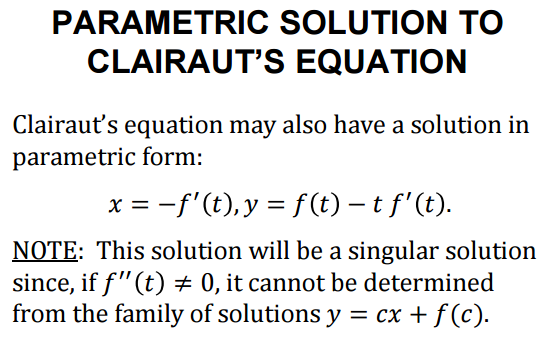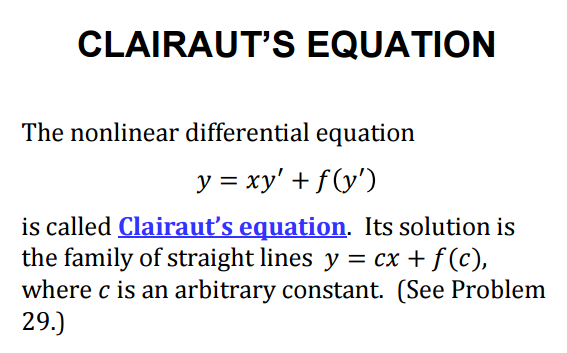Cauchy–Euler equation
- Case #1: Two distinct roots, m1 and m2
- Case #2: One real repeated root, m
- Case #3: Complex roots, α ± βi
 ∈ ℝ .
∈ ℝ .List of Maclaurin series of some common functions[edit]
.
-
-
Ratio test
-
The usual form of the test makes use of the limit
-
(1)
The ratio test states that:- if L < 1 then the series converges absolutely;
- if L > 1 then the series is divergent;
- if L = 1 or the limit fails to exist, then the test is inconclusive, because there exist both convergent and divergent series that satisfy this case.
-
-
Root test
-
converges then it equals C and may be used in the root test instead.The root test states that:
- if C < 1 then the series converges absolutely,
- if C > 1 then the series diverges,
- if C = 1 and the limit approaches strictly from above then the series diverges,
- otherwise the test is inconclusive (the series may diverge, converge absolutely or converge conditionally).
There are some series for which C = 1 and the series converges, e.g., and there are others for which C = 1 and the series diverges, e.g.
.
-
Integral test for convergence
-
Consider an integer N and a non-negative, continuous function f defined on the unbounded interval [N, ∞), on which it is monotone decreasing. Then the infinite seriesconverges to a real number if and only if the improper integralis finite. In other words, if the integral diverges, then the series diverges as well.
-
-
Alternating series test










![{\displaystyle {\begin{aligned}\sin x&=\sum _{n=0}^{\infty }{\frac {(-1)^{n}}{(2n+1)!}}x^{2n+1}&&=x-{\frac {x^{3}}{3!}}+{\frac {x^{5}}{5!}}-\cdots &&{\text{for all }}x\\[6pt]\cos x&=\sum _{n=0}^{\infty }{\frac {(-1)^{n}}{(2n)!}}x^{2n}&&=1-{\frac {x^{2}}{2!}}+{\frac {x^{4}}{4!}}-\cdots &&{\text{for all }}x\\[6pt]\tan x&=\sum _{n=1}^{\infty }{\frac {B_{2n}(-4)^{n}\left(1-4^{n}\right)}{(2n)!}}x^{2n-1}&&=x+{\frac {x^{3}}{3}}+{\frac {2x^{5}}{15}}+\cdots &&{\text{for }}|x|<{\frac {\pi }{2}}\\[6pt]\sec x&=\sum _{n=0}^{\infty }{\frac {(-1)^{n}E_{2n}}{(2n)!}}x^{2n}&&&&{\text{for }}|x|<{\frac {\pi }{2}}\\[6pt]\arcsin x&=\sum _{n=0}^{\infty }{\frac {(2n)!}{4^{n}(n!)^{2}(2n+1)}}x^{2n+1}&&&&{\text{for }}|x|\leq 1\\[6pt]\arccos x&={\frac {\pi }{2}}-\arcsin x\\&={\frac {\pi }{2}}-\sum _{n=0}^{\infty }{\frac {(2n)!}{4^{n}(n!)^{2}(2n+1)}}x^{2n+1}&&&&{\text{for }}|x|\leq 1\\[6pt]\arctan x&=\sum _{n=0}^{\infty }{\frac {(-1)^{n}}{2n+1}}x^{2n+1}&&&&{\text{for }}|x|\leq 1,\ x\neq \pm i\end{aligned}}}](https://wikimedia.org/api/rest_v1/media/math/render/svg/c1b4d4ff5aad4db6bdcf5ef9291660662e8d6d62)

![\lim_{n\rightarrow\infty}\sqrt[n]{|a_n|},](https://wikimedia.org/api/rest_v1/media/math/render/svg/55188338135041c09415e8b7fbdecfa62c65cb47)






























![{\begin{aligned}\sin(kx)&=P(D)y\\[8pt]&=P(D)(c_{1}y_{1}+c_{2}y_{2}+c_{3}y_{3}+c_{4}y_{4})\\[8pt]&=c_{1}P(D)y_{1}+c_{2}P(D)y_{2}+c_{3}P(D)y_{3}+c_{4}P(D)y_{4}\\[8pt]&=0+0+c_{3}(-k^{2}-4ik+5)y_{3}+c_{4}(-k^{2}+4ik+5)y_{4}\\[8pt]&=c_{3}(-k^{2}-4ik+5)(\cos(kx)+i\sin(kx))+c_{4}(-k^{2}+4ik+5)(\cos(kx)-i\sin(kx))\end{aligned}}](https://wikimedia.org/api/rest_v1/media/math/render/svg/1717700f7827bf9540c79cf81506777593436924)




![{\begin{aligned}y&=c_{1}y_{1}+c_{2}y_{2}+{\frac i{2(k^{2}+4ik-5)}}y_{3}+{\frac i{2(-k^{2}+4ik+5)}}y_{4}\\[8pt]&=c_{1}y_{1}+c_{2}y_{2}+{\frac {4k\cos(kx)-(k^{2}-5)\sin(kx)}{(k^{2}+4ik-5)(k^{2}-4ik-5)}}\\[8pt]&=c_{1}y_{1}+c_{2}y_{2}+{\frac {4k\cos(kx)+(5-k^{2})\sin(kx)}{k^{4}+6k^{2}+25}}.\end{aligned}}](https://wikimedia.org/api/rest_v1/media/math/render/svg/b05508bcdbe76c7f5874fa6b508ac763585efa85)















































































